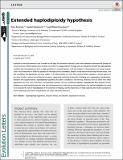Extended haplodiploidy hypothesis
Abstract
Evolution of altruistic behavior was a hurdle for the logic of Darwinian evolution. Soon after Hamilton formalized the concept of inclusive fitness, which explains how altruism can evolve, he suggested that the high sororal relatedness brought by haplodiploidy could be why Hymenopterans have a high prevalence in eusocial species, and why helpers in Hymenoptera are always female. Later it was noted that in order to capitalize on the high sororal relatedness, helpers would need to direct help toward sisters, and this would bias the population sex ratio. Under a 1:3 males:females sex ratio, the inclusive fitness valuation a female places on her sister, brother, and an own offspring are equal—apparently removing the benefit of helping over independent reproduction. Based on this argumentation, haplodiploidy hypothesis has been considered a red herring. However, here we show that when population sex ratio, cost of altruism, and population growth rate are considered together, haplodiploidy does promote female helping even with female‐biased sex ratio, due the lowered cost of altruism in such populations. Our analysis highlights the need to re‐evaluate the role of haplodiploidy in the evolution of helping, and the importance of fully exploring the model assumptions when comparing interactions of population sex ratios and social behaviors.
Citation
Rautiala , P T , Helanterä , H & Puurtinen , M 2019 , ' Extended haplodiploidy hypothesis ' , Evolution Letters , vol. 3 , no. 3 , pp. 263-270 . https://doi.org/10.1002/evl3.119
Publication
Evolution Letters
Status
Peer reviewed
ISSN
2056-3744Type
Journal article
Description
P.R., M.P., and H.H. were supported by Academy of Finland (grant 258385 to M.P., grant 135970 to H.H., and 252411 to the Centre of Excellence in Biological Interactions), P.R. also by the Royal Society Newton International Fellowship, and H.H. also by the Kone Foundation.Collections
Items in the St Andrews Research Repository are protected by copyright, with all rights reserved, unless otherwise indicated.

